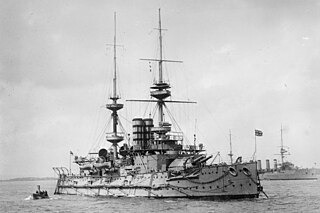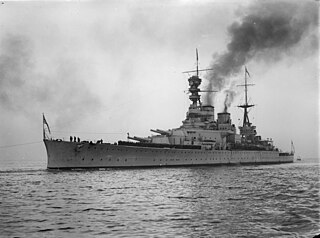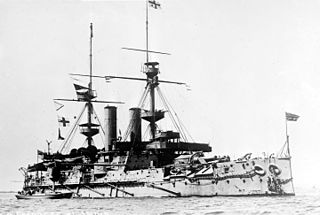
The King Edward VII class was a class of eight pre-dreadnought battleships launched by the Royal Navy between 1903 and 1905. The class comprised King Edward VII, the lead ship, Commonwealth, Hindustan, Britannia, Dominion, New Zealand, Africa, and Hibernia. They marked the first major development of the basic pre-dreadnought type that had been developed with the Majestic type of the mid-1890s, all of which had been designed by the Director of Naval Construction, William Henry White, with the primary innovation being the adoption of a heavy secondary battery of four 9.2-inch (234 mm) guns to supplement the standard main battery of four 12 in (305 mm) guns. The King Edward VIIs were among the last pre-dreadnoughts built for the Royal Navy before the construction and launch of the revolutionary battleship HMS Dreadnought in 1906, which immediately rendered them obsolescent.

HMS Triumph, originally known as Libertad, was the second of the two Swiftsure-class pre-dreadnought battleships of the Royal Navy. The ship was ordered by the Chilean Navy, but she was purchased by the United Kingdom as part of ending the Argentine–Chilean naval arms race. Triumph was initially assigned to the Home Fleet and Channel Fleets before being transferred to the Mediterranean Fleet in 1909. The ship briefly rejoined the Home Fleet in 1912 before she was transferred abroad to the China Station in 1913. Triumph participated in the hunt for the German East Asia Squadron of Maximilian Graf von Spee and in the campaign against the German colony at Qingdao, China early in World War I. The ship was transferred to the Mediterranean in early 1915 to participate in the Dardanelles Campaign against the Ottoman Empire. She was torpedoed and sunk off Gaba Tepe by the German submarine U-21 on 25 May 1915.

The Majestic class of nine pre-dreadnought battleships were built for the Royal Navy in the mid-1890s under the Spencer Programme, named after the First Lord of the Admiralty, John Poyntz Spencer. With nine units commissioned, they were the most numerous class of battleships. The nine ships, HMS Majestic, Caesar, Hannibal, Illustrious, Jupiter, Magnificent, Mars, Prince George, and Victorious, were built between 1894 and 1898 as part of a programme to strengthen the Royal Navy versus its two traditional rivals, France and Russia. This continued the naval re-armament initiatives begun by the Naval Defence Act 1889.

The Royal Sovereign class was a group of eight pre-dreadnought battleships built for the Royal Navy in the 1890s. The ships spent their careers in the Mediterranean, Home and Channel Fleets, sometimes as flagships, although several were mobilised for service with the Flying Squadron in 1896 when tensions with the German Empire were high following the Jameson Raid in South Africa. Three ships were assigned to the International Squadron formed when Greek Christians rebelled against the Ottoman Empire's rule in Crete in 1897–1898.

HMS Resolution was one of five Revenge-class battleships built for the Royal Navy during the First World War. Completed in December 1916, Resolution saw no combat during the war as both the British and German fleets adopted a more cautious strategy after the Battle of Jutland in May owing to the increasing threat of naval mines and submarines.

The Renown class consisted of two battlecruisers built during the First World War for the Royal Navy. They were originally laid down as improved versions of the Revenge-class battleships, but their construction was suspended on the outbreak of war on the grounds they would not be ready in a timely manner. Admiral Lord Fisher, upon becoming First Sea Lord, gained approval to restart their construction as battlecruisers that could be built and enter service quickly. The Director of Naval Construction (DNC), Eustace Tennyson-D'Eyncourt, quickly produced an entirely new design to meet Admiral Lord Fisher's requirements and the builders agreed to deliver the ships in 15 months. They did not quite meet that ambitious goal, but they were delivered a few months after the Battle of Jutland in 1916. They were the world's fastest capital ships upon their commissioning.

HMS Renown was the lead ship of her class of battlecruisers of the Royal Navy built during the First World War. She was originally laid down as an improved version of the Revenge-class battleships. Her construction was suspended on the outbreak of war on the grounds she would not be ready in a timely manner. Admiral Lord Fisher, upon becoming First Sea Lord, gained approval to restart her construction as a battlecruiser that could be built and enter service quickly. The Director of Naval Construction (DNC), Eustace Tennyson-D'Eyncourt, quickly produced an entirely new design to meet Admiral Lord Fisher's requirements and the builders agreed to deliver the ships in 15 months. They did not quite meet that ambitious goal, but the ship was delivered a few months after the Battle of Jutland in 1916. Renown, and her sister HMS Repulse, were the world's fastest capital ships upon completion.

The St Vincent-class battleships were a group of three dreadnought battleships built for the Royal Navy in the first decade of the 20th century. The sister ships spent their entire careers assigned to the Home and Grand Fleets. Aside from participating in the Battle of Jutland in May 1916 and the inconclusive action of 19 August several months later, their service during the First World War generally consisted of routine patrols and training in the North Sea. Vanguard was destroyed in 1917 by a magazine explosion with the near total loss of her crew. The remaining pair were obsolete by the end of the war in 1918, and spent their remaining time either in reserve or as training ships before being sold for scrap in the early 1920s.

The Courageous class consisted of three battlecruisers known as "large light cruisers" built for the Royal Navy during the First World War. The class was nominally designed to support the Baltic Project, a plan by Admiral of the Fleet Lord Fisher that was intended to land troops on the German Baltic Coast. Ships of this class were fast but very lightly armoured, with only a few heavy guns. They were given a shallow draught, in part to allow them to operate in the shallow waters of the Baltic but also reflecting experience gained earlier in the war. To maximize their speed, the Courageous-class battlecruisers were the first capital ships of the Royal Navy to use geared steam turbines and small-tube boilers.

HMS Nelson was the name ship of her class of two battleships built for the Royal Navy in the 1920s. They were the first battleships built to meet the limitations of the Washington Naval Treaty of 1922. Entering service in 1927, the ship spent her peacetime career with the Atlantic and Home Fleets, usually as the fleet flagship. During the early stages of World War II, she searched for German commerce raiders, missed participating in the Norwegian Campaign after she was badly damaged by a mine in late 1939, and escorted convoys in the Atlantic Ocean.

HMS Prince of Wales was a London-class pre-dreadnought battleship built for the Royal Navy in the first decade of the 20th century. She was one of two ships of the London- or Queen sub-class. Shortly after completion the ship was assigned to the Mediterranean Fleet and then to the Atlantic in 1909 and Home Fleets three year later. Prince of Wales often served as a flagship during her career.

The Colossus-class battleships were a pair of dreadnought battleships built for the Royal Navy (RN) at the end of the first decade of the 20th century, the last 12-inch-gunned (305 mm) battleships built for the RN. The sister ships spent their whole careers assigned to the Home and Grand Fleets, often serving as flagships. Aside from participating in the Battle of Jutland in May 1916, and the inconclusive action of 19 August several months later, their service during the First World War generally consisted of routine patrols and training in the North Sea.

The Lord Nelson class consisted of a pair of pre-dreadnought battleships built for the Royal Navy in the first decade of the twentieth century. Although they were the last British pre-dreadnoughts, both were completed and commissioned well over a year after HMS Dreadnought had entered service in late 1906. Lord Nelson and Agamemnon were assigned to the Home Fleet when completed in 1908, with the former ship often serving as a flagship. The sister ships were transferred to the Channel Fleet when the First World War began in August 1914. They were transferred to the Mediterranean Sea in early 1915 to participate in the Dardanelles Campaign.

HMS Swiftsure, originally known as Constitución, was the lead ship of the Swiftsure-class pre-dreadnought battleships. The ship was ordered by the Chilean Navy, but she was purchased by the United Kingdom as part of ending the Argentine–Chilean naval arms race. In British service, Swiftsure was initially assigned to the Home Fleet and Channel Fleets before being transferred to the Mediterranean Fleet in 1909. She rejoined Home Fleet in 1912 and was transferred to the East Indies Station in 1913, to act as its flagship.

HMS Revenge was one of seven Royal Sovereign-class pre-dreadnought battleships built for the Royal Navy during the 1890s. She spent much of her early career as a flagship for the Flying Squadron and in the Mediterranean, Home and Channel Fleets. Revenge was assigned to the International Squadron blockading Crete during the 1897–1898 revolt there against the Ottoman Empire. She was placed in reserve upon her return home in 1900, and was then briefly assigned as a coast guard ship before she joined the Home Fleet in 1902. The ship became a gunnery training ship in 1906 until she was paid off in 1913.

HMS Empress of India was one of seven Royal Sovereign-class pre-dreadnought battleships built for the Royal Navy during the 1890s. The ship was commissioned in 1893 and served as the flagship of the second-in-command of the Channel Fleet for two years. She was transferred to the Mediterranean Fleet in 1897, during which time Empress of India was assigned to the International Squadron blockading Crete during the uprising there. She returned home in 1901 and was briefly assigned as a coast guard ship in Ireland before she became the second flagship of the Home Fleet. The ship was reduced to reserve in 1905 and accidentally collided with the submarine HMS A10 the following year. Empress of India was taken out of service in early 1912 and accidentally struck a German sailing ship while under tow. She was sunk as a target ship in 1913.

The Centurion-class battleships were a pair of pre-dreadnought battleships built for the Royal Navy in the 1890s. They were rated as second-class battleships because they were less heavily armed and armoured than the first-class battleships. They were designed for service abroad and were given higher speed and longer range to counter the armoured cruisers then being built as commerce raiders.

HMS Centurion was the lead ship of her class of two pre-dreadnought battleships built for the Royal Navy in the 1890s. Intended for service abroad, they exchanged heavy armour and a powerful armament for high speed and long range to counter the foreign armoured cruisers then being built as commerce raiders and were rated as second-class battleships.

HMS Barfleur was the second and last of the Centurion-class pre-dreadnought battleships built for the Royal Navy in the 1890s. Intended for service abroad, they exchanged heavy armour and a powerful armament for high speed and long range to counter the foreign armoured cruisers then being built as commerce raiders and were rated as second-class battleships.

HMS Renown was a second-class predreadnought battleship built for the Royal Navy in the early 1890s. Intended to command cruiser squadrons operating on foreign stations, the ship served as the flagship of the North America and West Indies Station and the Mediterranean Fleet early in her career. Becoming obsolete as cruiser speeds increased, Renown became a royal yacht and had all of her secondary armament removed to make her more suitable for such duties. She became a stoker's training ship in 1909 and was listed for disposal in 1913. The ship was sold for scrap in early 1914.






















